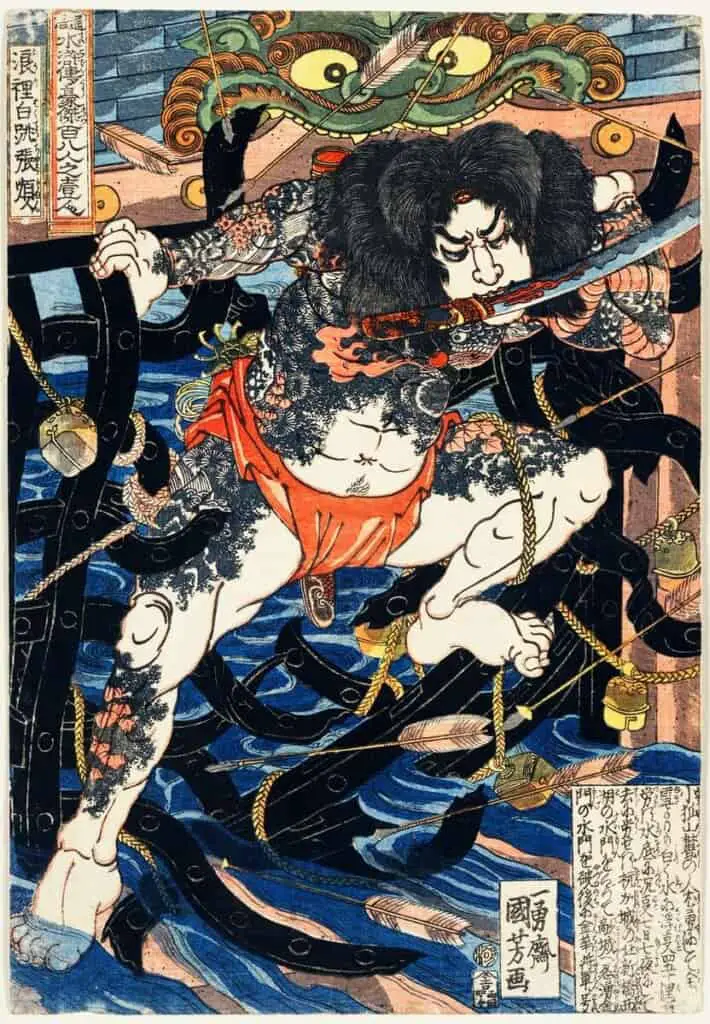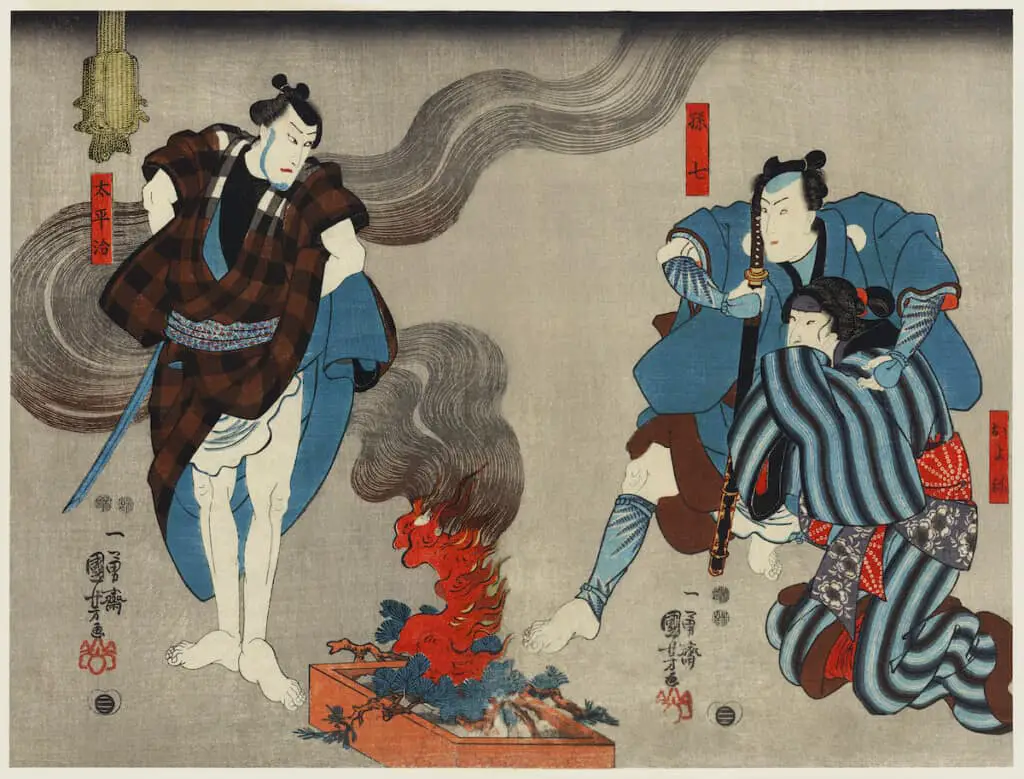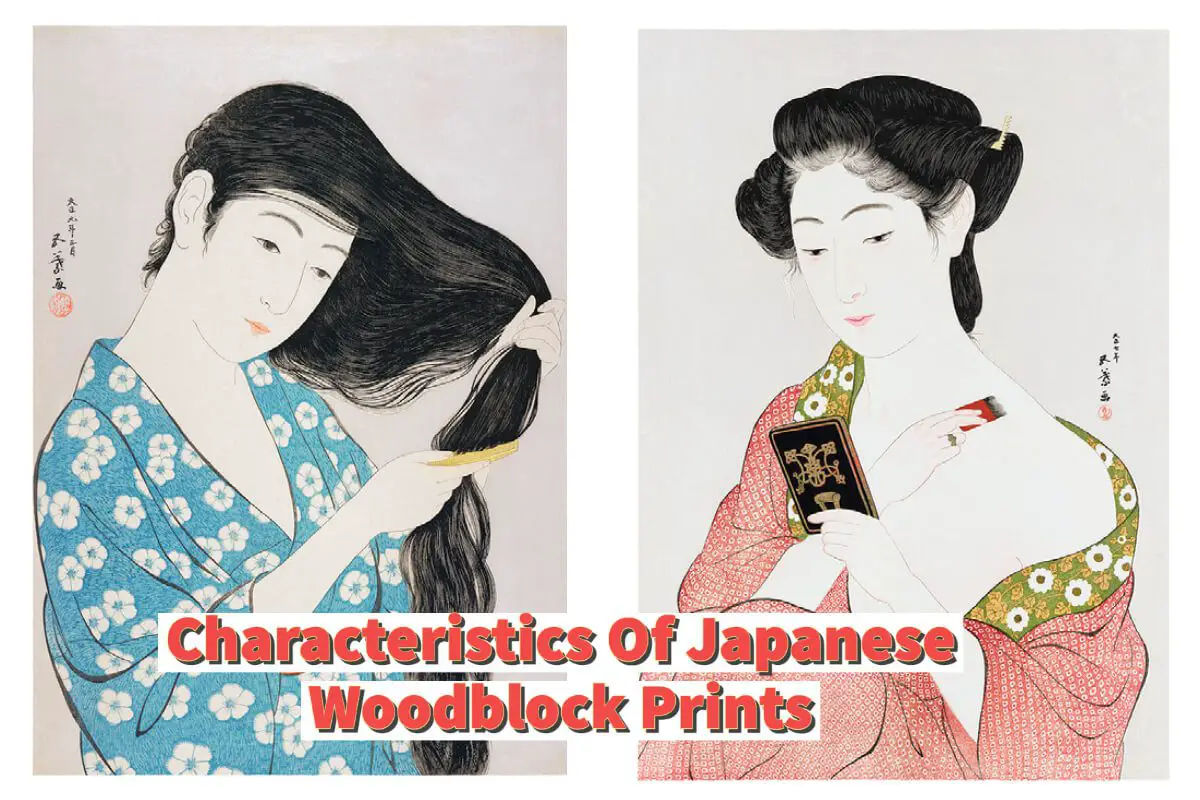As I was writing this blog, I talked to my mother, and she reminded me that our aunt gave us a woodblock print many years ago. My mother asked me if that woodblock print was a Japanese woodblock print. I told her it was not; it did not have the characteristics of a Japanese woodblock print.
There are many characteristics of a Japanese woodblock print, from the woodblock print title, artist name, and publisher’s seal; other characteristics also include the color and subject matter. Japanese woodblock prints also have different artistic art movements. Japan is not the only country that produces woodblock prints. Many other places and artists also use the same woodblock print technique. If you are not sure if a woodblock print is a Japanese-style woodblock print, there are some things you can look for to help you determine if it is a Japanese woodblock print.
Table of Contents
- Identifying Key Features of Japanese Woodblock Prints
- 4 Major Japanese Woodblock Print Art Movements and Their Characteristics
- Not All Japanese Woodblock Prints Are Created Equal
- Frequently Asked Questions
- Related Content
- Advantage Of The Woodblock Prints As Perfected By Japanese Artists
Identifying Key Features of Japanese Woodblock Prints
Japanese woodblock prints, renowned for their distinct aesthetic and cultural significance, exhibit several defining characteristics. These prints are often identifiable by their specific elements, such as the artist’s name, the title of the work, and the publisher’s seal.
Beyond these markers, the prints are distinguished by their unique color schemes and subject matter, which often reflect various artistic movements within Japan. While woodblock printing is a technique employed globally, Japanese woodblock prints possess certain qualities that set them apart.
For those new to this art form, understanding these distinctive features can significantly aid in recognizing and appreciating the nuances of Japanese woodblock print. Here are 11 significant characteristics you can look for to determine if your woodblock print is a Japanese woodblock print.
Japanese Written Characters
Most Japanese woodblock prints, especially the older ones, will have a series of written characters. To an untrained eye, these may look Chinese, but they are not Chinese but Japanese.
Classical Chinese influenced the old Japanese text, but even the classical Japanese text was meant to be read by Japanese readers and not Chinese readers.
So even if the writing may look Chinese to you, the writing is actually Japanese characters and meant for a Japanese, not a Chinese, audience. One of the first characteristics of a Japanese woodblock print is there will be some Japanese writing on the woodblock print.
Woodblock Print Title
Most of the Japanese woodblock prints would have a title to the print. The woodblock print title would sometimes distinguish the title from other parts of the woodblock print with a block around the characters or title.
The woodblock print title is one of 4 characteristics or components you will find on almost all woodblock prints.
The four typical components of a Japanese woodblock print usually include the woodblock print title, artist signature, the artist’s seal, and the publisher’s mark. The woodblock print title and other characteristics can help you determine and know this is a Japanese woodblock print.
Japanese Artist Woodblock Print Signature
The Japanese woodblock print artists would usually sign or mark their work. On the Japanese woodblock prints, the artist would carve their signature onto the woodblock or stamp it on the woodblock print.
In reality, these signatures are not very easy to read. As a chisel made the signatures onto the wood, the identical artistic signatures often look very different on woodblock prints made by the same artist. Because the signatures look so different, some of them are hard to identify.
After the artist’s name, many times, the artist would put the words in Japanese of “designed by.’ For some period of the woodblock art movement, these words were carved in what is known as Japanese “ga” or “hitsu” characters.
On some prints that may have been controversial for the time, the artist did not want their signature or mark on the print, so the signature or identification mark was omitted.

Japanese Artist Woodblock Print Seal
There is an artist seal on many Japanese woodblock prints, especially the ukiyo-e style woodblock prints. You can tell the artist’s seal as the seal is always done in red color.
An artist may use one seal for his entire career or periodically change the seal’s design. If he changed the seal, the artist’s seal can help determine the woodblock print date.
The artist’s seal was created by the artist and may reflect different aspects of the artist’s life. The seal could reflect family or studio crest, family names, significant emblems, masters or mentors, or other important aspects of the artist’s career or life.
Japanese Publisher Woodblock Print Mark
The publishers would also add their seal to the woodblock print. These publishers were not as well-known as many artists; Japanese publishers had a key role in the Japanese woodblock print process.
The artist designed the woodblock prints, but it was usually the publishers who oversaw the woodcutter who actually carved the woodblock for the print. The publishers were responsible for printing and inking the design onto paper. Sometimes, the publishers helped with the distribution of the prints.
The publisher had a vital role in the Japanese woodblock print process; they also added their mark or seal to the woodblock print.
The publisher’s mark was often located at the bottom left-hand side of the woodblock block opposite the signature. But some publishers placed their mark on other parts of the print, maybe because of design or other reasons.
Like the artist, the publishers also had some unique seals. Everything from their seal being an outline with two fishes – a scroll – a cat or even a bottle. The texts inside each publisher mark are different; different workers may have put something different inside the seal.
If the Japanese woodblock print was controversial, the artist might have omitted his mark and seal, but the publisher still sealed those works of art.
No Numbered Prints
One of the characteristics of Japanese woodblock prints, especially the old Japanese woodblock prints, and many modern ones, is that you will not find a concept of marking the prints as 1/100 or having a limited or first edition as in the West.
Any Japanese print produced before 1945 has no concept of limited editions, the numbering of prints, or hand signing. It is hard even to know the exact date of the woodblock print as they are usually not even dated.
The Japanese created the woodblock prints as long as they could sell them and the blocks did not deteriorate. For most Japanese woodblocks, you could print a maximum of 10,000 copies before remaking the woodblock.
The more the blocks were used for the printing, the more the print copy deteriorated. Even today, the most sought-after prints by Japanese woodblock collectors are those printed In the earlier print runs, as the quality of the woodblock print is usually better than the later print runs.
Japanese Woodblock Subject Matter
The Japanese woodblock prints have a variety of subject matter. Everything and almost any kind of subject matter has been made into a Japanese woodblock print.
Before 1945, most of the subject matter of the woodblock prints was scenes, landscapes, beautiful women (many prostitutes), flowers, birds, animals, theater actors, warriors, and characters from Japan’s history and legends.
The subject matter referred to the day’s scenes, such as the Sino-Japanese War (1894-1895) or the Russo-Japanese War (1904-1905). Other prints would show Westerners, western technology, and the industrialization of Japan.
After 1945 in the Modern era of Japanese woodblock prints, you can find any subject matter. Many modern Japanese woodblock artists have continued to make woodblock prints that are decidedly Japanese in subject matter and character.

Rich Color Palettes
The Japanese woodblock prints are rich in color palettes. The prints are radiant red, vivid blues and greens, and wonderful yellow tones. This rich color palette makes these Japanese woodblock prints popular even today.
What continues to make this printing process so unique is that many artists and printmakers achieved such detail in the shading of the woodblock prints. The colors and the precision of how they executed the colors with the woodblock prints are characteristics of these Japanese woodblock prints.
Use Of Bold Black Lines
The Japanese woodblock print masters were able to use black lines to contrast their rich color palettes. The woodblock print artists were masters of knowing when and how to use the black lines and how thick or thin they should be for the effect they wanted on their woodblock prints.
Japanese woodblock print artists prefer strong shapes and graphic designs with bold black lines. The use of these black lines is something that continues to influence many artists today.
I love the strong black lines and have used them in my artwork. I admire and love how these Japanese artists could eloquently execute their work using the black lines.
4 Major Japanese Woodblock Print Art Movements and Their Characteristics
The world of Japanese woodblock prints is rich and varied, spanning several major art movements, each with its unique characteristics and styles.
These movements reflect the artistic evolution in Japan and mirror the cultural and societal changes of their times. Here’s a look at some of the major Japanese woodblock print art movements and what makes each distinct.
Ukiyo-e (17th – 19th Century)
Ukiyo-e, which translates to “pictures of the floating world,” is perhaps the most famous of the Japanese woodblock print movements. This period is characterized by its focus on the transient pleasures of life, with subjects ranging from beautiful courtesans and kabuki actors to landscapes and historical tales.
The prints are known for their vibrant colors, flat areas of color, and emphasis on linear outlines. Artists like Hokusai and Hiroshige made this style iconic with works such as “The Great Wave off Kanagawa” and “The Fifty-Three Stations of the Tokaido.”
Shin-hanga (Early 20th Century)
The Shin-Hanga movement emerged in the early 20th century as a response to the changing times. It brought a modern twist to the traditional Ukiyo-e style, combining Western influences with Japanese techniques.
This movement is noted for its romantic landscapes, exquisite portrayals of women (bijin-ga), and vivid depictions of nature. The prints often blend soft, Western-style shading and the bold outlines of traditional Ukiyo-e, as seen in the works of artists like Hasui Kawase and Ito Shinsui.
Sosaku-hanga (Mid-20th Century)
Sosaku-hanga, meaning “creative prints,” marked a significant shift in the Japanese woodblock printing tradition. This movement emphasized the artist’s personal involvement in every stage of printmaking, from design to carving and printing.
It celebrated individual expression and artistic freedom, often veering towards abstract and experimental styles. Artists like Koshiro Onchi and Shiko Munakata were pioneers of this movement, creating prints that were both deeply personal and stylistically innovative.
Contemporary Woodblock Prints
Contemporary Japanese woodblock artists continue to explore and expand the boundaries of the medium. Today’s artists often experiment with new techniques, materials, and themes while still respecting traditional craftsmanship.
The contemporary scene is diverse, with artists creating works that range from the highly traditional to the modern and abstract, showcasing the enduring adaptability and appeal of the woodblock print.
Each of these movements contributed uniquely to developing Japanese woodblock printing, a testament to Japan’s rich artistic heritage. Their enduring influence can be seen in these prints’ continued popularity and reverence, both in Japan and around the world.
Not All Japanese Woodblock Prints Are Created Equal
If you want to buy or sell a Japanese woodblock print, one of the first characteristics you must understand is that not all Japanese woodblock prints are created equal. You could have the same Japanese woodblock print as someone else, and your print could be worth much less or nothing because of the print’s condition.
Things that can damage the value of print would be faded colors, trimmed or cut-off margins, creases, spots, dirt, and more. All of this can damage the value of any Japanese woodblock prints. Prints framed and exposed to light can be damaged and be deemed invaluable as the colors are faded.
That is why many collectors may keep their most valuable prints stored in a cabinet between two sheets of acid-free paper and frame their reproductions or less valuable prints on the wall.
A Japanese woodblock print may not even be valuable or saleable. There are so many conditions and variables to Japanese woodblock prints that only the most experienced collectors or experts can really advise you.
If you have a print you would like to have accessed or valued, I would try to find a local expert that you can talk to. That way, they can see the print and help you access it if it has any value. There are just so many variables that can make a difference in a Japanese woodblock print value.
Anita Louise Art is dedicated to art education, great artists, and inspiring others to find and create their art. We love art that uplifts and inspires. #ArtToMakeYouSmile! #ArtToMakeYouHappy!
If you want to see any of my art, you can find out more by clicking here. If you are interested in what inspires me and my paintings, you can discover more by clicking here.
We have a free newsletter and would love you to be part of our community; you can subscribe to the newsletter by clicking here. If you have any questions, I would be happy to talk to you anytime. You can reach me, Anita, by clicking here.
Subscribe to our Anita Louise Art YouTube Channel with great videos and information by clicking here.
Join us for our podcast “5 Minutes With Art.” Spend just 5 minutes a week with us to discover and learn about great art and artists. You can find out more about our podcast by clicking here.
Frequently Asked Questions
What are the key characteristics of a Japanese woodblock print?
Japanese woodblock prints typically exhibit distinct features such as the title, artist’s name, publisher’s seal, color palette, and subject matter. Understanding these elements can help identify a print’s origin.
How can I distinguish a Japanese woodblock print from other types of prints?
Look for specific traits like the use of vibrant colors, intricate details, and the presence of Japanese characters or seals. These elements are often unique to Japanese woodblock prints.
What role do titles and artist names play in identifying Japanese woodblock prints?
Titles and artist names are crucial components. Authentic Japanese woodblock prints will have the artist’s name and a title written in Japanese characters, contributing to their cultural authenticity.
What is the significance of the publisher’s seal on a Japanese woodblock print?
The publisher’s seal provides additional information about the print’s production and distribution. It can aid in tracing the print back to a specific workshop or publisher.
Are there specific color palettes associated with Japanese woodblock prints?
Yes, Japanese woodblock prints often feature a distinctive use of colors, including bold and contrasting hues. Understanding traditional color schemes can help in differentiating them from prints of other origins.
How does subject matter contribute to identifying Japanese woodblock prints?
Subject matter is another key factor. Japanese woodblock prints often depict scenes from nature, kabuki actors, landscapes, and everyday life. Recognizing these themes can assist in determining the print’s origin.
Do Japanese woodblock prints follow specific artistic movements?
Yes, Japanese woodblock prints are associated with various artistic movements such as Ukiyo-e and Shin-hanga. Understanding these movements can provide insights into the historical and cultural context of the print.
Can prints from other countries use the woodblock print technique?
Yes, many places and artists worldwide use the woodblock print technique. However, each region may have its unique style, themes, and characteristics that distinguish them from Japanese woodblock prints.
How can I verify if a woodblock print is a Japanese-style woodblock print?
Check for the presence of Japanese characters, specific artistic elements, and traditional themes. Additionally, researching the artist and understanding the historical context of the print can help in verification.
What if I have a woodblock print, but I’m unsure if it’s Japanese?
Look for visual cues like the use of Japanese characters, traditional themes, and vibrant colors. Consulting experts or art historians can also provide valuable insights into the print’s origin and authenticity.
Related Content
Advantage Of The Woodblock Prints As Perfected By Japanese Artists
The Japanese woodblock prints had many advantages, and that it was beneficial technology for its day. The more the Japanese publishers began to print woodblock art, the easier it became to print more complicated and intricate designs. They were then able to sell this duplicated art to the masses.
You can discover more by reading Advantage Of The Woodblock Prints As Perfected By Japanese Artists by clicking here.
What Is A Japanese Woodblock Print?
A Japanese woodblock print is, as the name implies, a print that is made by using carved woodblock and applying ink on the woodblocks to print a design on paper. The Japanese woodblock artists use woodblocks to print artistic prints and even books. Artists have used the woodblock print technique in Japan for hundreds of years.
You can learn more by reading What Is A Japanese Woodblock Print? by clicking here.


